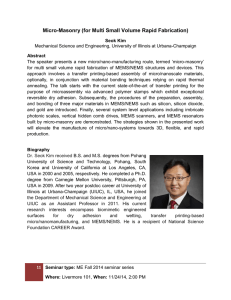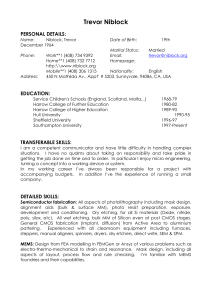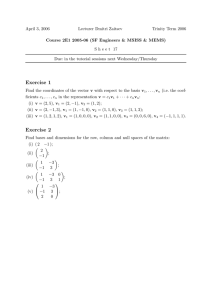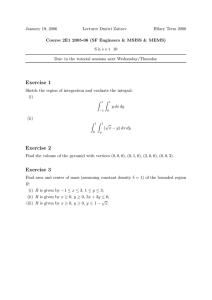MEMS Accelerometer Design & Simulation with COMSOL
advertisement
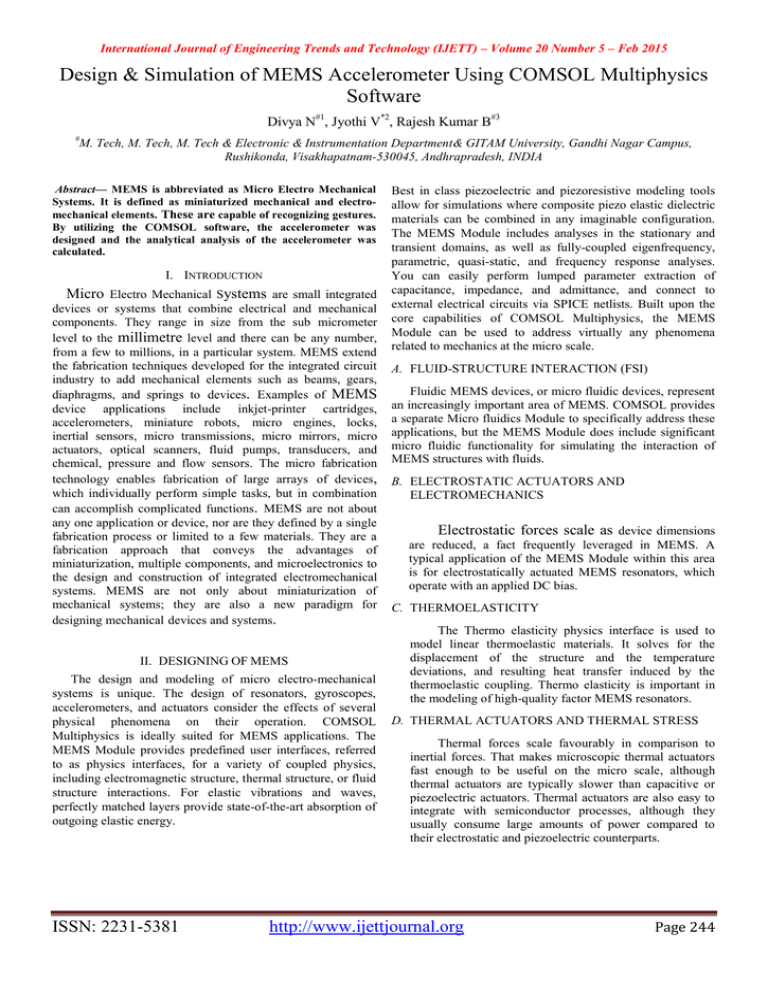
International Journal of Engineering Trends and Technology (IJETT) – Volume 20 Number 5 – Feb 2015 Design & Simulation of MEMS Accelerometer Using COMSOL Multiphysics Software Divya N#1, Jyothi V*2, Rajesh Kumar B#3 # M. Tech, M. Tech, M. Tech & Electronic & Instrumentation Department& GITAM University, Gandhi Nagar Campus, Rushikonda, Visakhapatnam-530045, Andhrapradesh, INDIA Abstract— MEMS is abbreviated as Micro Electro Mechanical Systems. It is defined as miniaturized mechanical and electromechanical elements. These are capable of recognizing gestures. By utilizing the COMSOL software, the accelerometer was designed and the analytical analysis of the accelerometer was calculated. I. INTRODUCTION Micro Electro Mechanical Systems are small integrated devices or systems that combine electrical and mechanical components. They range in size from the sub micrometer level to the millimetre level and there can be any number, from a few to millions, in a particular system. MEMS extend the fabrication techniques developed for the integrated circuit industry to add mechanical elements such as beams, gears, diaphragms, and springs to devices. Examples of MEMS device applications include inkjet-printer cartridges, accelerometers, miniature robots, micro engines, locks, inertial sensors, micro transmissions, micro mirrors, micro actuators, optical scanners, fluid pumps, transducers, and chemical, pressure and flow sensors. The micro fabrication technology enables fabrication of large arrays of devices, which individually perform simple tasks, but in combination can accomplish complicated functions. MEMS are not about any one application or device, nor are they defined by a single fabrication process or limited to a few materials. They are a fabrication approach that conveys the advantages of miniaturization, multiple components, and microelectronics to the design and construction of integrated electromechanical systems. MEMS are not only about miniaturization of mechanical systems; they are also a new paradigm for designing mechanical devices and systems. II. DESIGNING OF MEMS The design and modeling of micro electro-mechanical systems is unique. The design of resonators, gyroscopes, accelerometers, and actuators consider the effects of several physical phenomena on their operation. COMSOL Multiphysics is ideally suited for MEMS applications. The MEMS Module provides predefined user interfaces, referred to as physics interfaces, for a variety of coupled physics, including electromagnetic structure, thermal structure, or fluid structure interactions. For elastic vibrations and waves, perfectly matched layers provide state-of-the-art absorption of outgoing elastic energy. ISSN: 2231-5381 Best in class piezoelectric and piezoresistive modeling tools allow for simulations where composite piezo elastic dielectric materials can be combined in any imaginable configuration. The MEMS Module includes analyses in the stationary and transient domains, as well as fully-coupled eigenfrequency, parametric, quasi-static, and frequency response analyses. You can easily perform lumped parameter extraction of capacitance, impedance, and admittance, and connect to external electrical circuits via SPICE netlists. Built upon the core capabilities of COMSOL Multiphysics, the MEMS Module can be used to address virtually any phenomena related to mechanics at the micro scale. A. FLUID-STRUCTURE INTERACTION (FSI) Fluidic MEMS devices, or micro fluidic devices, represent an increasingly important area of MEMS. COMSOL provides a separate Micro fluidics Module to specifically address these applications, but the MEMS Module does include significant micro fluidic functionality for simulating the interaction of MEMS structures with fluids. B. ELECTROSTATIC ACTUATORS AND ELECTROMECHANICS Electrostatic forces scale as device dimensions are reduced, a fact frequently leveraged in MEMS. A typical application of the MEMS Module within this area is for electrostatically actuated MEMS resonators, which operate with an applied DC bias. C. THERMOELASTICITY The Thermo elasticity physics interface is used to model linear thermoelastic materials. It solves for the displacement of the structure and the temperature deviations, and resulting heat transfer induced by the thermoelastic coupling. Thermo elasticity is important in the modeling of high-quality factor MEMS resonators. D. THERMAL ACTUATORS AND THERMAL STRESS Thermal forces scale favourably in comparison to inertial forces. That makes microscopic thermal actuators fast enough to be useful on the micro scale, although thermal actuators are typically slower than capacitive or piezoelectric actuators. Thermal actuators are also easy to integrate with semiconductor processes, although they usually consume large amounts of power compared to their electrostatic and piezoelectric counterparts. http://www.ijettjournal.org Page 244 International Journal of Engineering Trends and Technology (IJETT) – Volume 20 Number 5 – Feb 2015 Design steps for X-Deformation: 1) Open the COMSOL Multiphysics software. 2) Select 3D and click on forward arrow on top. 3) Select solid mechanics and click on forward arrow. 4) Select stationary and click on flag symbol, then a new window is created. 5) Select length unit as a µm. 6) Right click on the geometry and then select block. Likewise different blocks are created according to required dimensions. 7) To union all the blocks right click on the geometry, then select Boolean operations in that select Union. Select all the blocks created. 8) Right click on the solid mechanics and then select fixed constraints. In that the edges which we have to fix are to be selected one by one. 9) To add a material to model for this right click on the materials, then select open material browser, then select MEMS, then select Semiconductors in that right click on the Silicon material and then select Add material to model. 10) Meshing is to be done to the model in order to reduce the errors. Right click on the mesh 1 and then select free tetrahedral. 11) Right click on the solid mechanics and then select boundary load. Select the surface on which we have to apply force. Note the amount of force that is to be applied on the surface of the proof mass on the left side column i.e., Fx=10 N/m2 in X-direction. 12) Right click on Study 1 and then click on compute. Then the model is subjected to force on X-direction. 13) A graph is plotted so that stress in the beams is observed. To plot a graph Right click on the 1D plot group 2, then select line graph. For that select a line or arc of any one of the beams which the proof mass is supported. The amount of displacement occurs in the proof mass is shown in the form of graph below: Design steps for Y-Deformation: Same as X-Deformation from step 1-14 except in the 10th step note the amount of force in the Fy=10N/m2. . The amount of displacement occurs in the proof mass is shown in the form of graph below: To plot the 3D graph to the model Right click on the 3D plot group 3 and then click on plot. A 3D model is observed. Design steps for Z-Deformation: Same as X and Y-Deformations except in the 10th step note the amount of force applied in the Z-direction as Fz=10N/m2. ISSN: 2231-5381 http://www.ijettjournal.org Page 245 International Journal of Engineering Trends and Technology (IJETT) – Volume 20 Number 5 – Feb 2015 The amount of displacement occurs in the proof mass is shown in the form of graph below:- The amount of displacement occurs in the proof mass is shown in the form of graph below: Analytical Design The proof-mass length, width, thickness are represented as l1, b1, h1. The L- Beam dimensions are represented by l2, l3, b2, and h2 respectively. The optimized device dimensions are given below. Proofmass size (l1 X b1 X h1): 10 X 10X 2 (μm)3 Length of beam (l2): 4.5 μm Length of beam (l3): 5 μm Beam Width (b2): 1 μm Beam thickness (h2): 1 μm Air gap: 22 μm Area of proof-mass (A) = l1 X b1 = 100x10-12 m2 Mass of proof-mass (m) = V. ρ Perforations: = (A x h1) x ρ = 23x10-14 Kg (Density of the silicon ρ = 2300kg/m^3, V = Volume of Same as step 1-14 except in between the step 6 & step 7. proof-mass) Perforations (holes) are created one by one of required Let ‘F’ be the force acting on the proof mass, due to size. For that right click on the geometry then select block. 1 g acceleration, A block is created of required size. Right click on the geometry, and then select Boolean operations in that F= m x a select difference. For this select the block (hole) which Where ‘m’ is the mass of the proof-mass and ‘a’ is the we have to subtract from the proof mass. Difference is acceleration, F = 23 X 10-14 X 9.81 X 1 = 225.63 X 10-14 N done and a hole is created on the proof mass. Likewise Force acting on each beam W = F/4 = 0.5640 X 10-12 N some holes are created on the proof mass. For example a force is applied to the proof mass in x-direction b2 h23 I ( ) 0.0833 X 1048 m4 Moment of Inertia of beams: i.e.,Fx=10 N/m2.It is shown below: 12 Deflection of the beam: Where E = Modulus of elasticity for silicon E = 1.69 x 10 11 N/m2. I = moment of inertia of beam. For beam having length l2: For beam having length l3: ISSN: 2231-5381 http://www.ijettjournal.org Page 246 International Journal of Engineering Trends and Technology (IJETT) – Volume 20 Number 5 – Feb 2015 C2 45.16597 109 pF C C2 C1 8.9038 109 pF Bending stress in beam: b M y I Where, σb = Bending stress in the beam M = Bending moment acting on the beam y = the perpendicular distance to the neutral axis. At 30 g, REFERENCES M W l2 30 1. L. Zhao, E. M. Yeatman (Optical and Semiconductor Devices Group, Department of Electrical & Electronic Engineering, Imperial College London, SW7 2AZ, UK). Micro Capacitive Tilt Sensor for Human Body Movement Detection M 76.14 10 18 Nm h Zhenchuan Yang*, Guizhen Van, Yilong Hao, Guoying Wu (Institute of y 2 0.5 106 m2. For maximum bending stress, Microelectronics, Peking University, Beijing 100871, China). Design and 2 Fabrication of a Torsional Z-axis Capacitive Accelerometer with Novel Com b Capacitor b 457.022811018 MPa 3. Tolga Kaya, Behrouz Shiari, Kevin Petsch1 and David Yates (Central Michigan University, University of Michigan). Design of a MEMS Capacitive Comb drives Accelerometer. 4. Larissa Schudlo (McMaster University)(2010). A System to Quantify Limb Function . Lab VIEW 2011 Help - National Instruments Where, Relative permittivity of the dielectric Upper 5. Sam Naghshineh, Golafsoun Ameri, Mazdak Zereshki, Dr. S. Krishnan & r medium (for Air) Dr. M. Abdoli-Eramaki. Human Motion Capture using Tri-Axial accelerometers. -2 6. Martin Baker. Maths Euler Angle, from Permittivity of free space = 8.85 x 10 F/m. o http://www.euclideanspace.com/maths/geometry/rotations/euler/index.html C0 = 40.227 x 10-9 pF. C1 r o a d C1 36.26217 109 pF a C2 r o d ISSN: 2231-5381 http://www.ijettjournal.org Page 247
